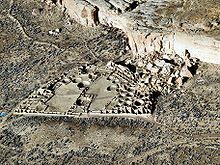Pueblo Bonito
Pueblo Bonito is the largest structure in Chaco Canyon , New Mexico . The Pueblo culture built and inhabited this structure between 823 and 1126 AD. Pueblo Bonito was discovered in 1849 during a military campaign. In 1941 a large stone slab fell from a rock, destroying the back wall and some rooms. Traces indicate that the residents of Pueblo Bonito ( Anasazi ?) Traded with Central Americans, including cocoa and ceramics.
history
Pueblo Bonito was built by the Chaco Canyon culture in the 800s. For 300 years, Pueblo Bonito was an important cultural center for both ceremonies and trade in what is likely to be turquoise . In the 1100s or 1200s, the people of Chaco Canyon and Pueblo Bonito moved because of a drought.
discovery
In 1849 the Pueblo Bonito was opened by Lt. James H. Simpson and his Indian guide Carravahal. After that military campaign, Simpson published a description of Pueblo Bonito and some other buildings in Chaco Canyon, including drawings by RH Kern.
Between 1896 and 1900 , excavations were carried out on the Chaco Canyon site by Richard Wetherill and a student at the American Museum of Natural History , George H. Pepper. They explored 190 rooms and made maps. The excavations were funded by two New York philanthropists and collectors , B. Talbot Hyde and Fredrick E. Hyde Jr. After the excavations, they gave almost all of the artifacts to the American Museum of Natural History.
description
Pueblo Bonito is divided into two parts by a wall that goes from north to south. There is a large kiva on either side of the wall . The structures make the terrain almost symmetrical, a feature of many pueblo cultural structures. About thirty other kivas were found, as well as a large courtyard and spacious living area.
Pueblo Bonito is almost 8,000 m² with over 800 rooms. Other sources speak of 650 rooms, with a length of 206 m and a width of 96 m. At the height of development, 600 or more rooms were being used. Estimates of the pueblo's population vary from 70 to more than 1,000. It is likely, however, that the Pueblo Bonito was more of a ritual center than a permanently inhabited city, as the area could not support a larger population and there is no archaeological evidence of permanent settlement (e.g., rubbish heaps and larger burial grounds).
Some of the buildings in Pueblo Bonito are up to five floors tall. Many of the lower floors are filled with rubble so that they can support the upper floors. The living spaces are very large compared to other pueblo buildings. The rooms are connected with doorways and can only be entered through a courtyard.
There are several different construction methods that reflect the respective construction period. The walls are up to one meter thick and built using the “core and veneer” method, i.e. H. with mud in the center of the wall and stone on the sides. The walls were decorated with stucco, of which nothing can be seen today. When the Pueblo Bonito was built, the Chaco Canyon area was still forested, e.g. B. with yellow pine . When building the houses and for firewood, almost all of the trees in the area were then used up. This led to the desiccation of the soil and a drop in the water table, which probably led to the abandonment of the pueblo in the 12th century.
Petroglyphs
Like other pueblo structures, Pueblo Bonito has many petroglyphs within and around the site. Often the petroglyphs show traces of the knowledge of the Pueblo residents , e.g. B. about the moon and the solar cycle.
Web links
Individual evidence
- ↑ Jared Diamond: The Third Chimpanzee . Fischer Taschenbuch Verlag, Frankfurt am Main 2000, ISBN 978-3-10-013912-2 , p. 414

